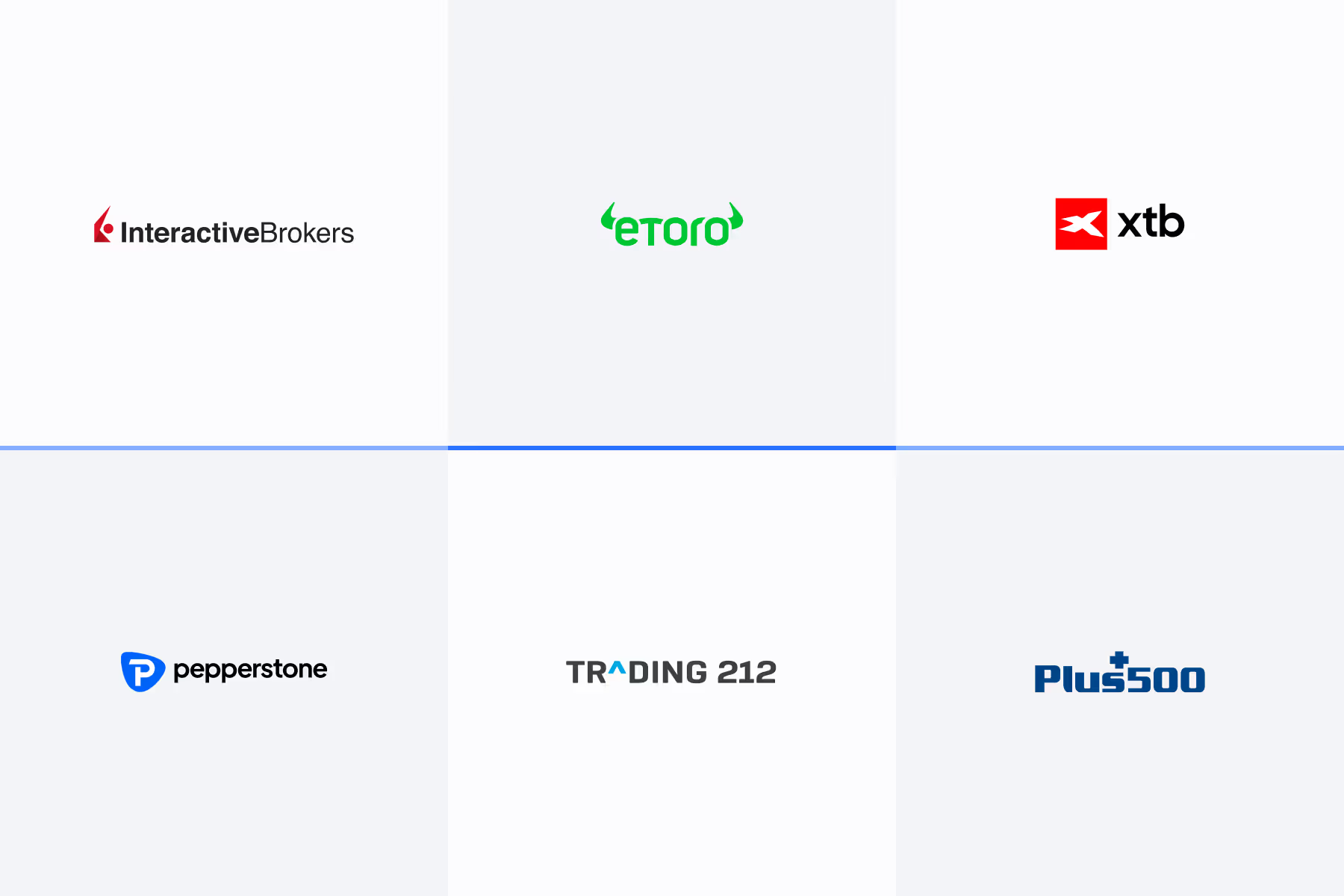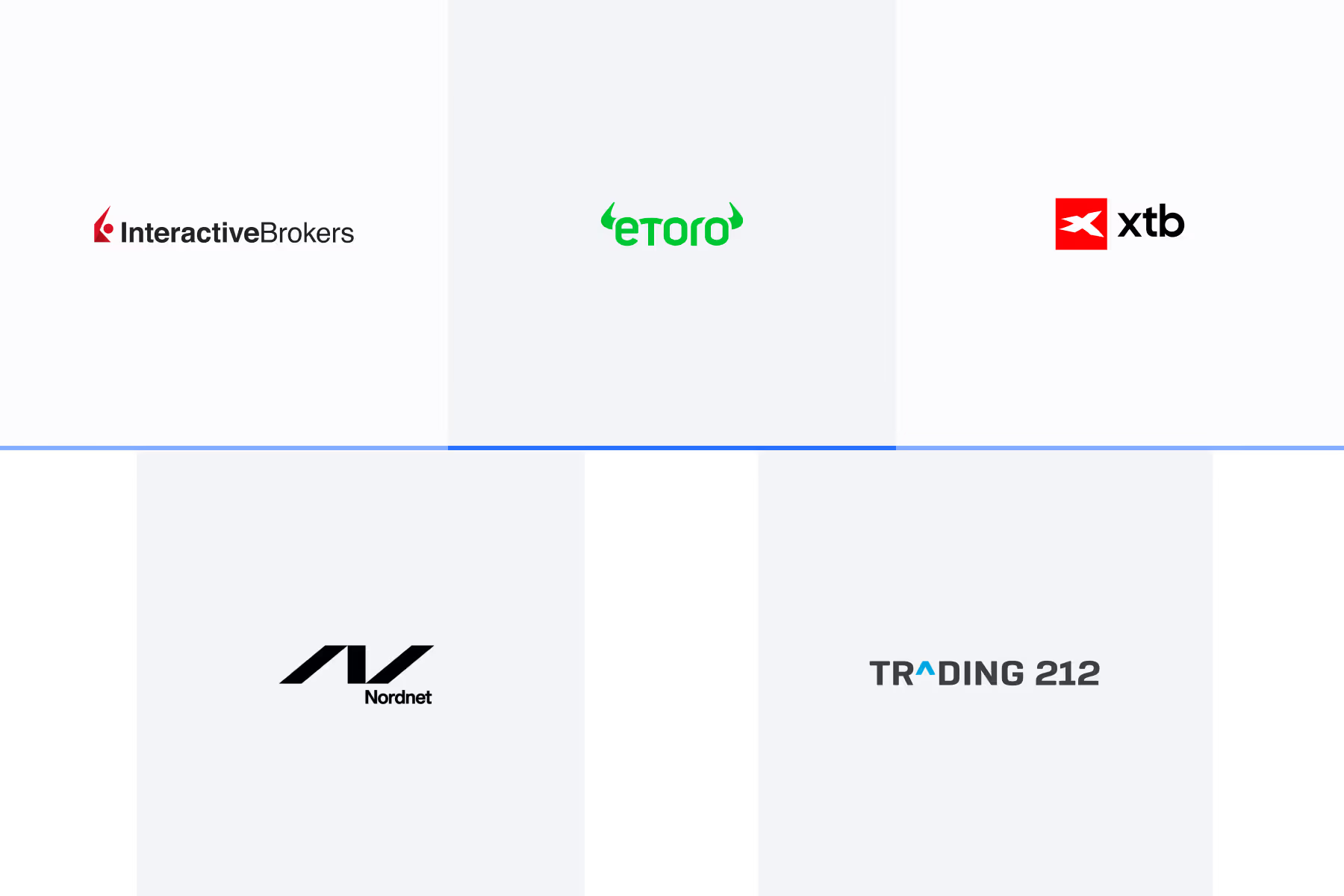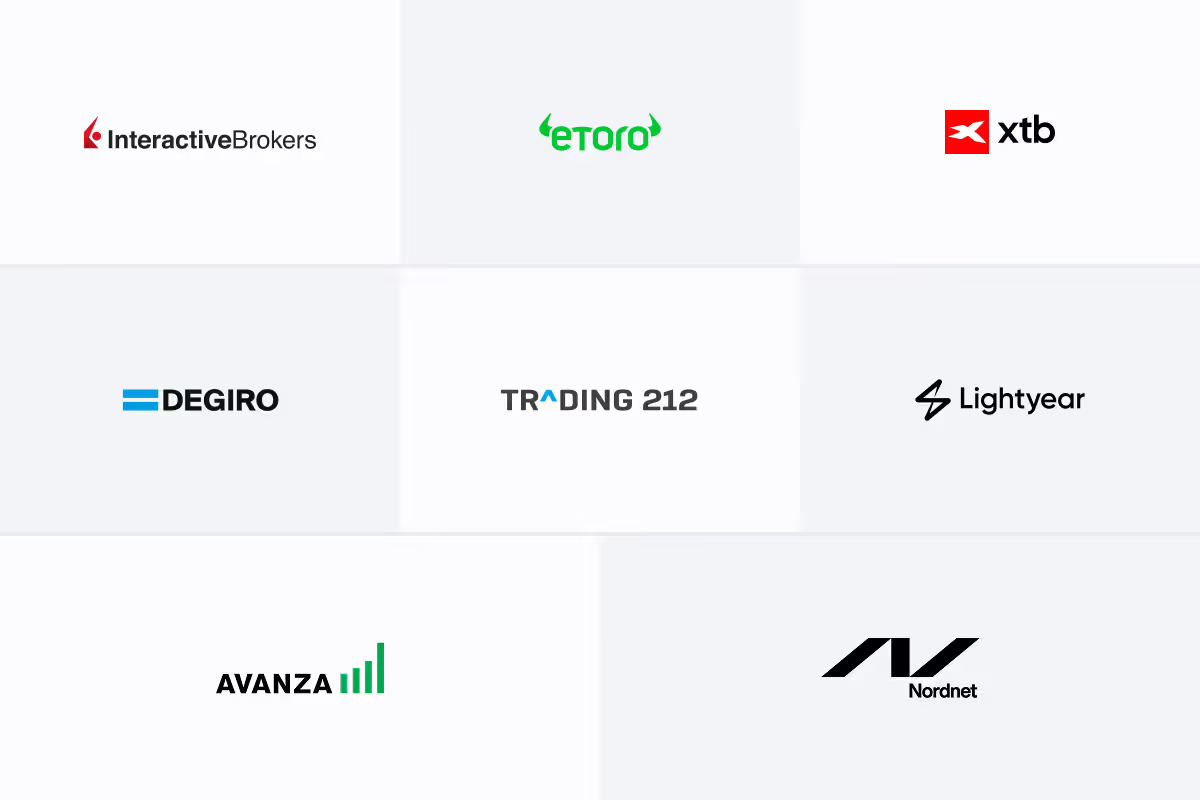Capital.com review for European investors (2025)
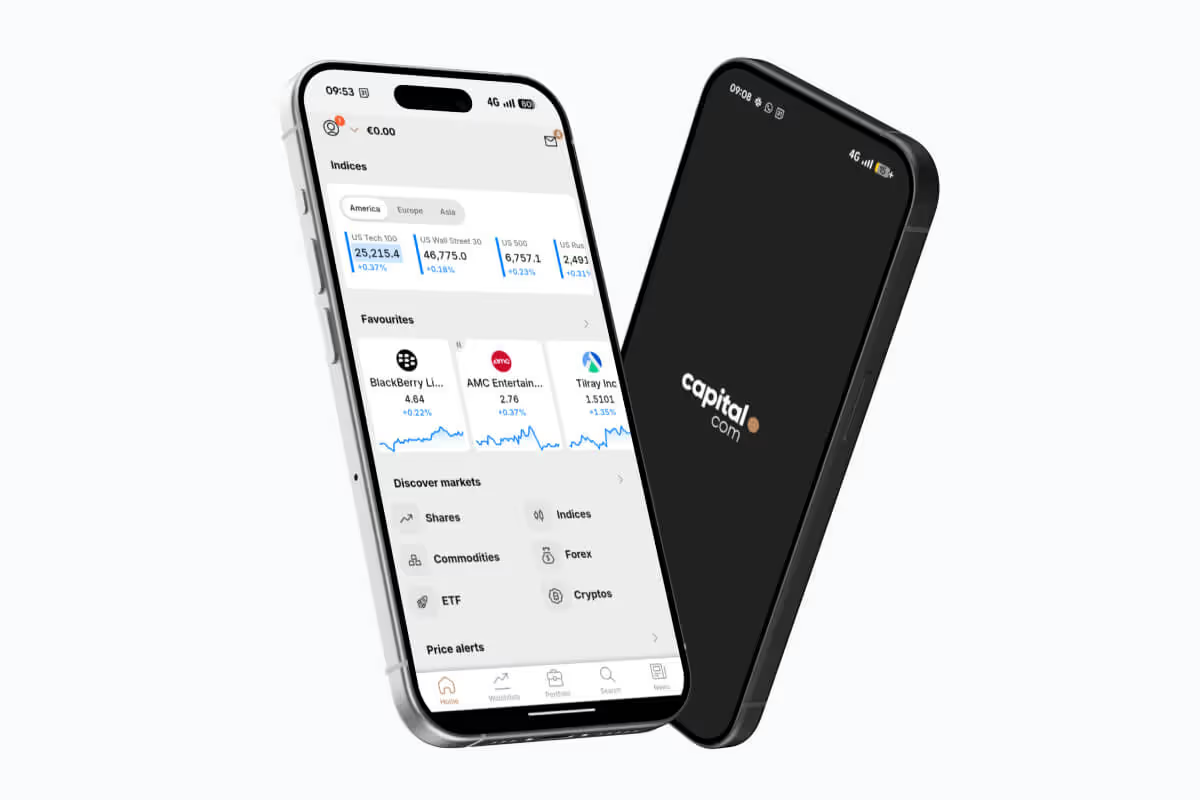

Capital.com is a European trading platform that offers access to thousands of financial instruments, including stocks, indices, commodities, forex, and cryptocurrencies, all through CFDs (Contracts for Difference). This means investors can speculate on price movements without owning the underlying asset.
Capital.com stands out for its zero-commission structure (still, spreads apply) and access to a wide variety of markets. It’s particularly suited for active traders who want to trade short-term price fluctuations using leverage.
However, it’s not designed for long-term investors, as it doesn’t offer ownership of real shares or ETFs, and overnight financing fees (due to leverage) apply to open positions. For long-term investing, these brokers will probably be a better fit.
The broker is fully regulated by CySEC in the European Union (EU), ensuring compliance with European financial laws. It offers segregated client funds for security and is subject to the Cypriot investor compensation scheme, which protects up to €20,000 per investor.
In this article, we’ll take a detailed look at the main features of Capital.com, including its fees, functionality, advantages, and limitations, to help you decide if it’s the right platform for you.
Overview
Launched in 2016, Capital.com is one of Europe’s best-known CFD brokers with over 770,000 investors worldwide. The platform provides access to over 5,000 markets, including shares, ETFs, indices, forex pairs, commodities, and cryptocurrencies, all available as CFDs only.
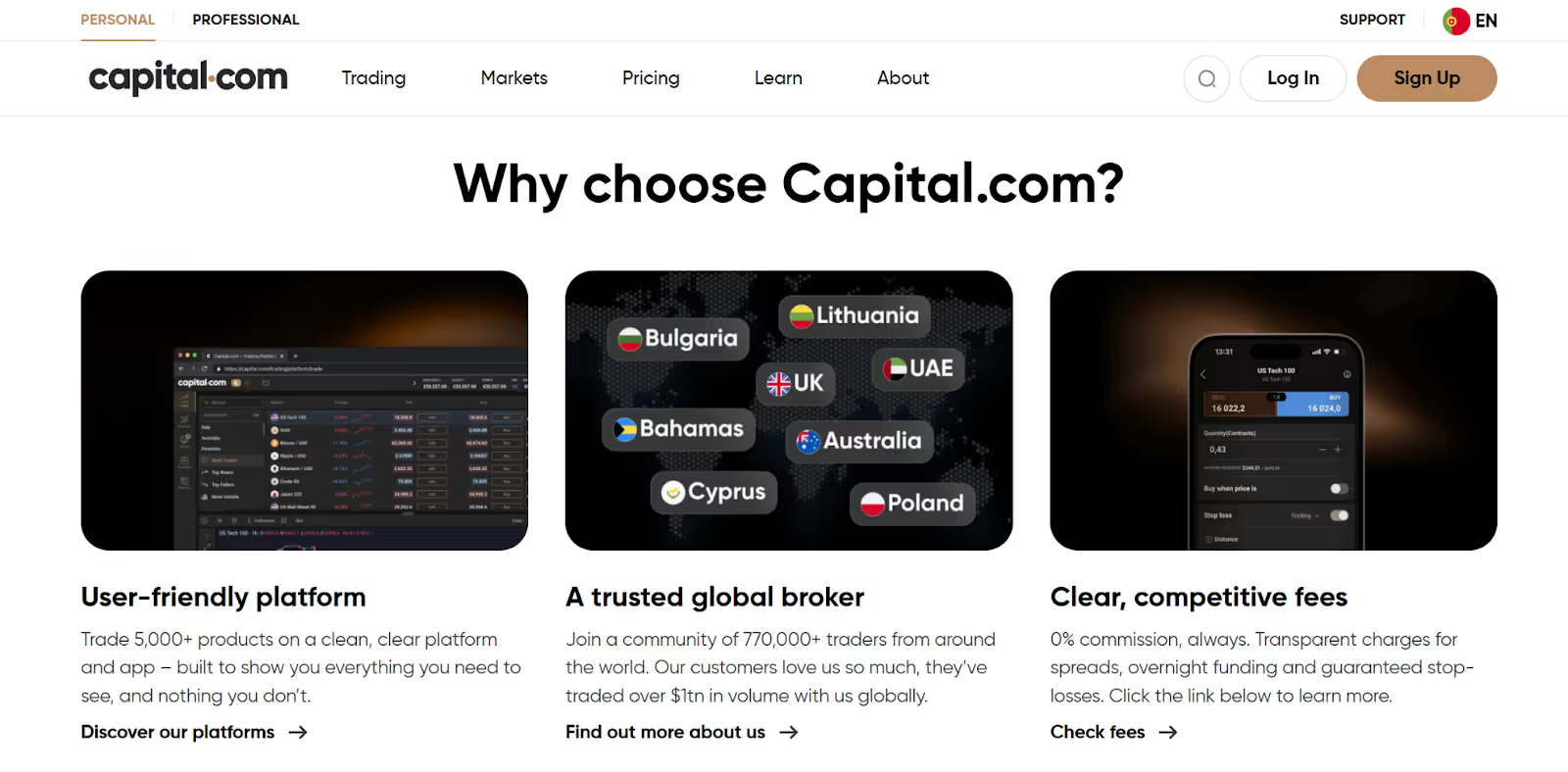
Operating under a “commission-free” model, Capital.com earns its revenue mainly through spreads (the difference between buy and sell prices) and overnight financing fees for leveraged positions held open after market hours (explained in detail in the “Fees and commissions” section).
Capital.com’s trading tools, educational resources, and sleek interface make it especially attractive to beginner and intermediate traders. For experienced investors seeking algorithmic or chart-based trading, Capital.com also integrates with MetaTrader 4 (MT4) and TradingView, expanding its functionality significantly.
That said, since all assets are CFDs, users do not acquire ownership rights or dividends from the underlying stocks or ETFs, a key distinction for anyone focused on long-term investing.
Highlights
Pros and cons
Pros
- 0% commission trading (only spreads apply)
- User-friendly web and mobile platforms
- Integration with MT4 and TradingView
- Wide range of tradable assets (over 5,000 markets)
- Minimum deposit of €20
- 24/7 index CFD trading
- Excellent educational resources, including guides and webinars
- Demo account
Cons
- No ownership of underlying assets (CFD trading only)
- Overnight financing fees can add up for long-term traders. Overnight financing charges apply if you hold positions beyond each day’s close.
- Not suitable for passive or dividend investors
- No interest on uninvested cash
Account types
Capital.com offers Retail and Professional accounts in accordance with EU regulations.
- Retail account: Ideal for most users (the target audience of this review). Includes negative balance protection, leverage limits under ESMA (up to 1:30 for major forex pairs, 1:5 for stocks), and access to all CFD products.
- Professional account: Available for traders meeting specific criteria (experience, portfolio size, trading volume). Allows higher leverage, but removes some retail protections.
There are no separate tiers (like “Basic” or “Trader”) as in some brokers. All Capital.com users access the same core functionality, differing mainly by their regulatory classification.
Trading platform
Capital.com provides four main platforms:
Web Platform
The web platform is intuitive and fast, making it easy to place trades or analyse markets, even if you’re not an experienced trader. The layout is clean: on a typical screen, you’ll see your watchlists, open positions, and order tickets on one side, and a large, customisable chart in the main area.
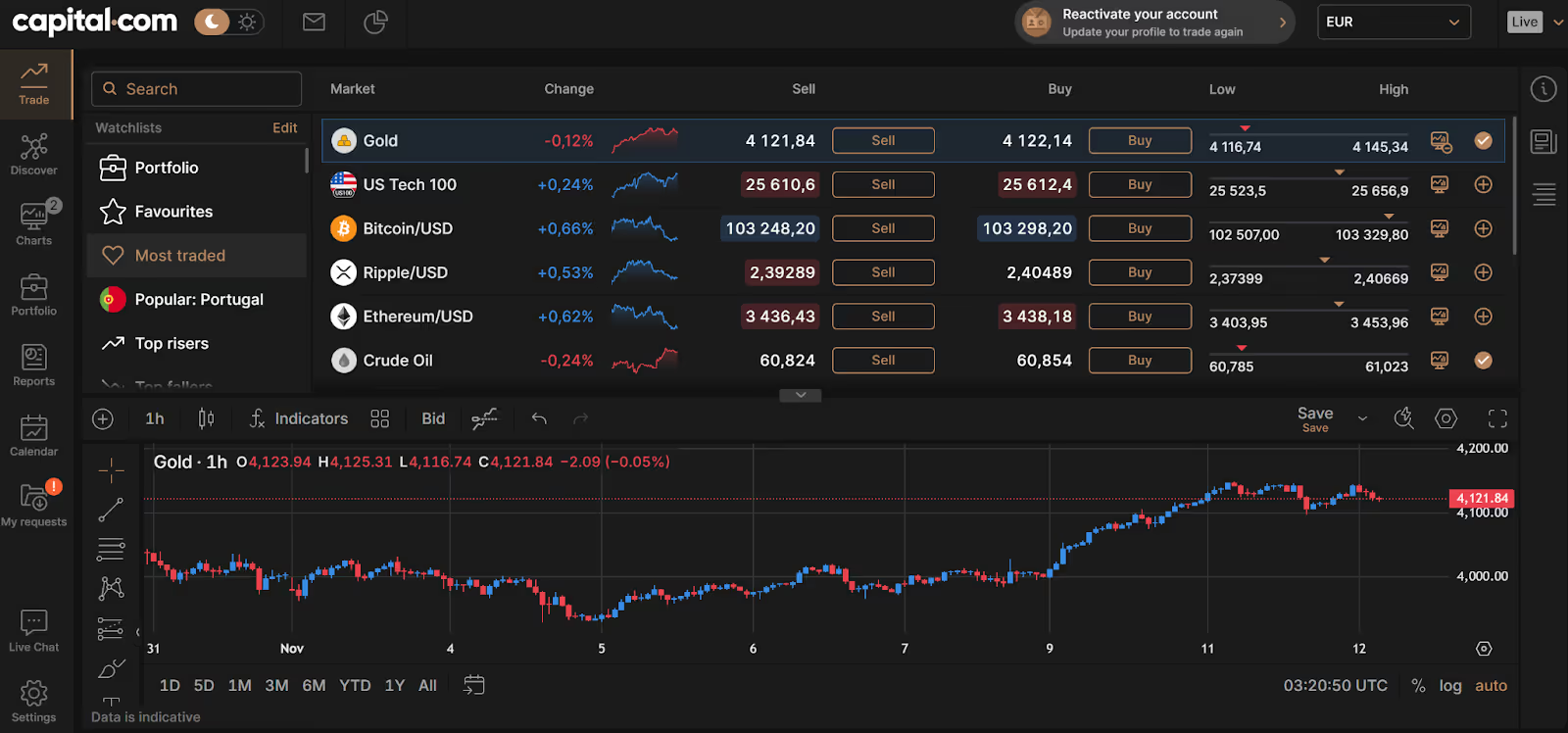
You can search for instruments by name, ticker, or asset class (stocks, indices, forex, commodities, crypto CFDs), and add them to your favourites with a single click. Each instrument page displays key information, including current bid/ask prices, daily percentage change, price range, and fundamentals where available.
In terms of analysis, the platform includes advanced charting tools with multiple timeframes (from 1-minute charts for day traders to daily and weekly charts for swing traders), more than 70 technical indicators, and a range of drawing tools (trendlines, Fibonacci retracements, channels, and more). You can switch between chart types (line, bar, candlestick, etc.) and save chart layouts for future use.
Order placement is straightforward. From the instrument page or directly from the chart, you can open a buy or sell CFD position, choose your position size, and set stop-loss and take-profit levels at the same time.
The platform also shows margin requirements, estimated costs, and potential profit/loss before you confirm the order, which is especially important when trading leveraged products like CFDs. Real-time news and fundamental sentiment indicators may be available for certain markets, enabling you to stay informed about potential market movements without leaving the platform.
Mobile app
Available for iOS and Android, the Capital.com mobile app mirrors the desktop experience with real-time price alerts, charting tools, and AI-based trading insights. The app also features a “demo mode” for practising with virtual funds.
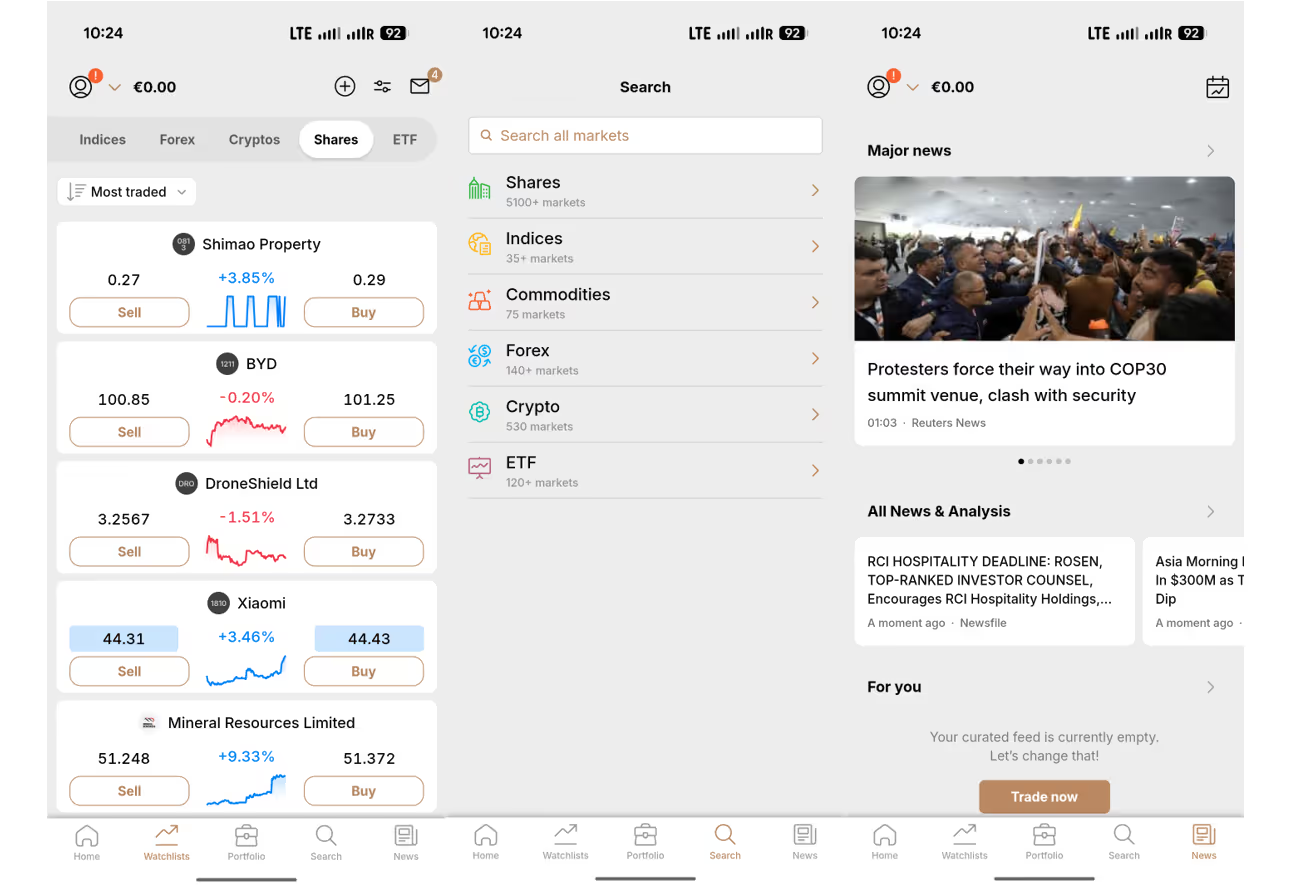
MetaTrader 4 (MT4)
For experienced traders, Capital.com also integrates with MetaTrader 4 (MT4), a platform that differs from Capital.com’s proprietary web and mobile platforms in several ways.
While Capital.com’s own interface focuses on simplicity, clean design, and accessibility for beginners, MT4 is built for professional and algorithmic trading. It supports Expert Advisors (EAs), allowing you to automate strategies and run them 24/5 directly on your account. This makes it ideal for traders who want to backtest strategies, use custom scripts, or run automated systems without manual execution.

MT4 also offers deeper technical analysis capabilities: traders can install thousands of custom indicators, create their own analytical tools using the MQL4 scripting language, and open multiple chart windows simultaneously with advanced customisation options.
TradingView
Capital.com’s integration with TradingView offers a powerful alternative to both its native platform and MT4.
While Capital.com’s own platform focuses on simplicity and MT4 excels in automation, TradingView stands out for its charting depth and social trading features. Users can connect their Capital.com account directly to TradingView and execute trades straight from the TradingView charts.

TradingView provides access to hundreds of technical indicators, highly customisable chart layouts, and multi-timeframe analysis. It also supports Pine Script, a proprietary scripting language that allows traders to build and share custom strategies or indicators.
A unique advantage of TradingView is its global community: traders can share charts, ideas, and technical setups publicly or follow others’ analyses in real time. This social dimension adds an educational layer and helps traders discover new strategies or market perspectives.
Markets and products
Capital.com provides access to a broad range of CFDs, including:
- Stocks: Trade CFDs on global companies listed on exchanges like NASDAQ, NYSE, LSE, and Euronext.
- ETFs: Exposure to popular ETFs through CFDs.
- Indices: Major indices such as DAX 40, CAC 40, FTSE 100, S&P 500, and Euro Stoxx 50.
- Forex: Over 130 currency pairs, including EUR/USD, GBP/USD, and EUR/JPY.
- Commodities: Precious metals, oil, natural gas, and agricultural products.
- Cryptocurrencies: Bitcoin, Ethereum, Litecoin, and others. Again, available as CFD instruments.

Because all these instruments are CFDs, you don’t own the underlying assets, but can trade both long and short with leverage.
24/5 Index CFD Trading
Capital.com offers 24/5 trading on major global index CFDs. This feature enables continuous access from Sunday to Friday (UTC), letting you trade before markets open and after they close.
Indices available for 24/5 trading include popular benchmarks such as the EU Stocks 50, Germany 40, UK 100, US 500, US Tech 100, Japan 225, and Hong Kong 50. Prices are derived from live futures markets, ensuring ongoing price action even when underlying exchanges are shut.
Execution quality remains the same as during regular hours, with transparent spreads, fast order execution (average 0.082 seconds, August 2025), and no additional trading restrictions. However, trading outside standard hours may involve lower liquidity and wider spreads, increasing volatility and potential risk.
Fees and commissions
*The currency conversion fee is included in the exchange rate you receive.
How Capital.com makes money
Capital.com operates under a zero-commission model, meaning you don’t pay a fixed trading commission when opening or closing positions.
Instead, the broker earns revenue through several channels built into its CFD pricing and trading structure.
Here’s how Capital.com makes money:
1. Spreads
The spread is the difference between the buy (ask) and sell (bid) price of a tradable instrument, and it’s the primary source of Capital.com’s revenue. Every time you open a position, you effectively pay this difference as the cost of entering the trade.
Spreads vary depending on:
- Market liquidity: popular markets like EUR/USD or gold typically have tighter spreads than less-traded assets like agricultural commodities.
- Volatility: during highly volatile periods, spreads may widen as market conditions change.
Capital.com show this example for CFDs on Apple stocks:
- You hold a position of 10 shares on Apple, with a bid/offer quote of $240.00 / $240.13.
- The spread on this market is therefore 0.13 points ($240.13 − $240.00).
- When you open the position, you pay half of the spread (0.065 points).
- When you close the position, you pay the other half (0.065 points).
- The total cost of the spread is 10 shares × 0.13 points = $1.30 (or the currency equivalent).
This simple example illustrates how spreads directly translate into trading costs: the larger your position size or the wider the spread, the greater your total cost. In highly liquid markets such as Apple shares, spreads tend to be tight, meaning your effective trading costs remain relatively low compared to less liquid instruments.
For major forex pairs like EUR/USD, spreads can be ~0.6 to 0.8 pips under normal market conditions.
2. Overnight funding
When you hold a leveraged CFD position overnight, Capital.com applies a daily financing charge (or sometimes pays interest if you’re in a position that earns funding). This overnight funding fee compensates the broker for the cost of loaning money used to maintain leveraged positions outside market hours.
Example of buying a CFD on one Adidas stock:
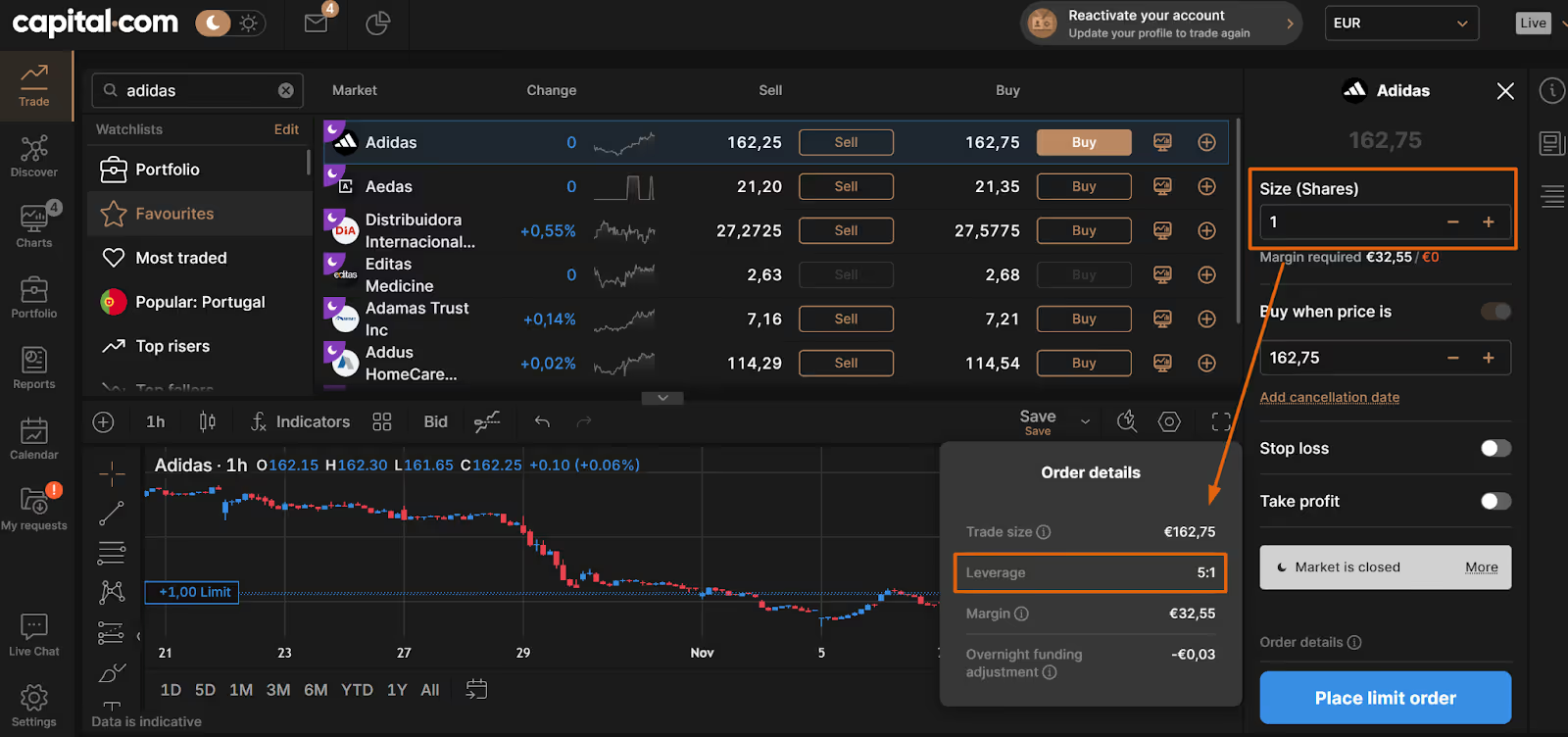
As you can see, one Adidas share is at “€162.75”, but my margin requirement is only “€32,55”. In other words, I only need €32.55 of my own money to invest €162.75. The difference of €130.20 (€162.75 - €32.55) is borrowed money.
You can see where this amount of leverage comes from if you look at the “order details” and read “leverage 5:1”.
All in all, funding rates depend on the:
- Type of asset (forex, index, stock, or commodity)
- Direction of your trade (long or short)
- Applicable benchmark interest rate (e.g., SONIA or SOFR)
- Daily Capital.com fee
Why overnight fees add up for long-term investors:
Swap (overnight) fees are charged every single day you hold a CFD position open.
Over weeks or months, these small daily costs accumulate into a significant percentage of your capital.
That means:
- Even if the underlying index or stock rises, your financing cost eats away at your profit.
- If markets move sideways, the swap fees alone can turn your trade into a loss.
For indices, Capital.com charges an annual daily fee of around 4%, plus or minus the relevant interest-rate benchmark (such as SOFR or SONIA). In practice, that means the total annual cost can reach around 9% of your total position value - not just your invested capital.
And if you’re using leverage, the swap is applied to your full market exposure, not the smaller amount you actually deposited. For example, if you invest $1,000 with 1:10 leverage, your exposure is $10,000, and the daily financing cost is calculated on that $10,000.
While the fees may seem small daily, they can add up quickly, making holding CFDs long-term an expensive strategy.
3. Guaranteed Stop-Loss Orders (GSL)
A Guaranteed Stop-Loss Order ensures that your trade closes at your specified price level, even if the market gaps or moves sharply against you. This eliminates the risk of “slippage”, when a standard stop order executes at a worse price than expected.
However, the guarantee comes at a premium fee that is only charged if the GSL is triggered. It’s an optional risk-management tool that provides certainty about potential losses, but it incurs a small additional cost when used.
Formula for the GSL fee:

4. Currency conversion fees
This fee applies when you trade an asset denominated in a currency different from your account’s base currency. As a European investor, your account will most likely be denominated in EUR, and if you trade a USD instrument (such as US companies), a 0.70% currency conversion fee applies.
Security and regulation
Capital.com operates in Europe through Capital Com SV Investments Ltd, regulated by the Cyprus Securities and Exchange Commission (CySEC) under licence number 319/17.
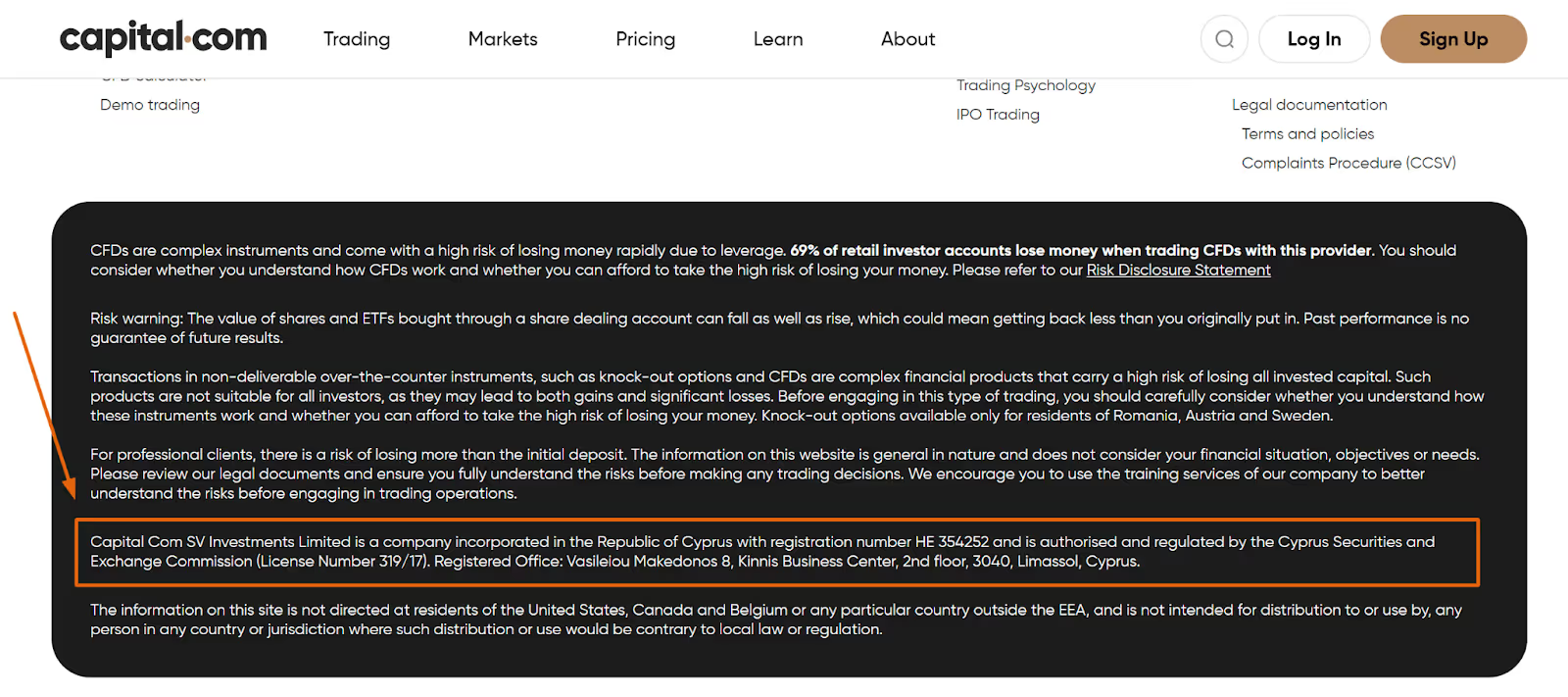
All client funds are held in segregated bank accounts at reputable, top-tier European financial institutions. This means that your money is kept completely separate from Capital.com’s own corporate funds and cannot be used for operational or investment purposes by the company.
In practice, this segregation ensures that, in the unlikely event of broker insolvency, client balances are ring-fenced and should be returned to their rightful owners.
If the firm were to become insolvent and could not return client funds, investors may be eligible for compensation under the Cyprus Investor Compensation Fund (ICF). This fund protects up to €20,000 per client, covering 90% of the amount owed:

However, it’s important to note that the ICF does not cover trading losses. If your investment decreases in value due to market movements, those losses are entirely your responsibility. The ICF only applies if Capital.com itself fails to return your funds or assets, not if a trade goes against you.
Additionally, under EU law, all retail clients are protected from negative balance when trading CFDs. This means your account balance can never fall below zero: you cannot lose more money than you deposit.
Warning signs
In well-regulated regions (like the EU, the UAE, or the UK), Capital.com tends to act professionally. However, in offshore jurisdictions, such as their former Bahamas or Seychelles entities, the story could be different.
One user has recorded a video laying out many of the issues he and other users faced.
Some of the issues reported in offshore jurisdictions include:
- Blocked or delayed withdrawals, often with ‘verification’ or ‘funding source’ excuses.
- High overnight fees, even on non-leveraged positions.
- Aggressive internal trading practices, where the broker could take the opposite side of clients’ trades.
- Inconsistent customer service, where local agents give conflicting explanations depending on which entity you’re under.
When opening an account on Capital.com, ensure you sign up under the European/British entity, not any offshore one.
Opening an account
Opening a Capital.com account is fast and fully digital:
- Sign up via email or social login.
- Verify your identity with an official document and proof of address.
- Complete a suitability questionnaire (required by EU law).
- Deposit funds via bank transfer, card, or e-wallet.
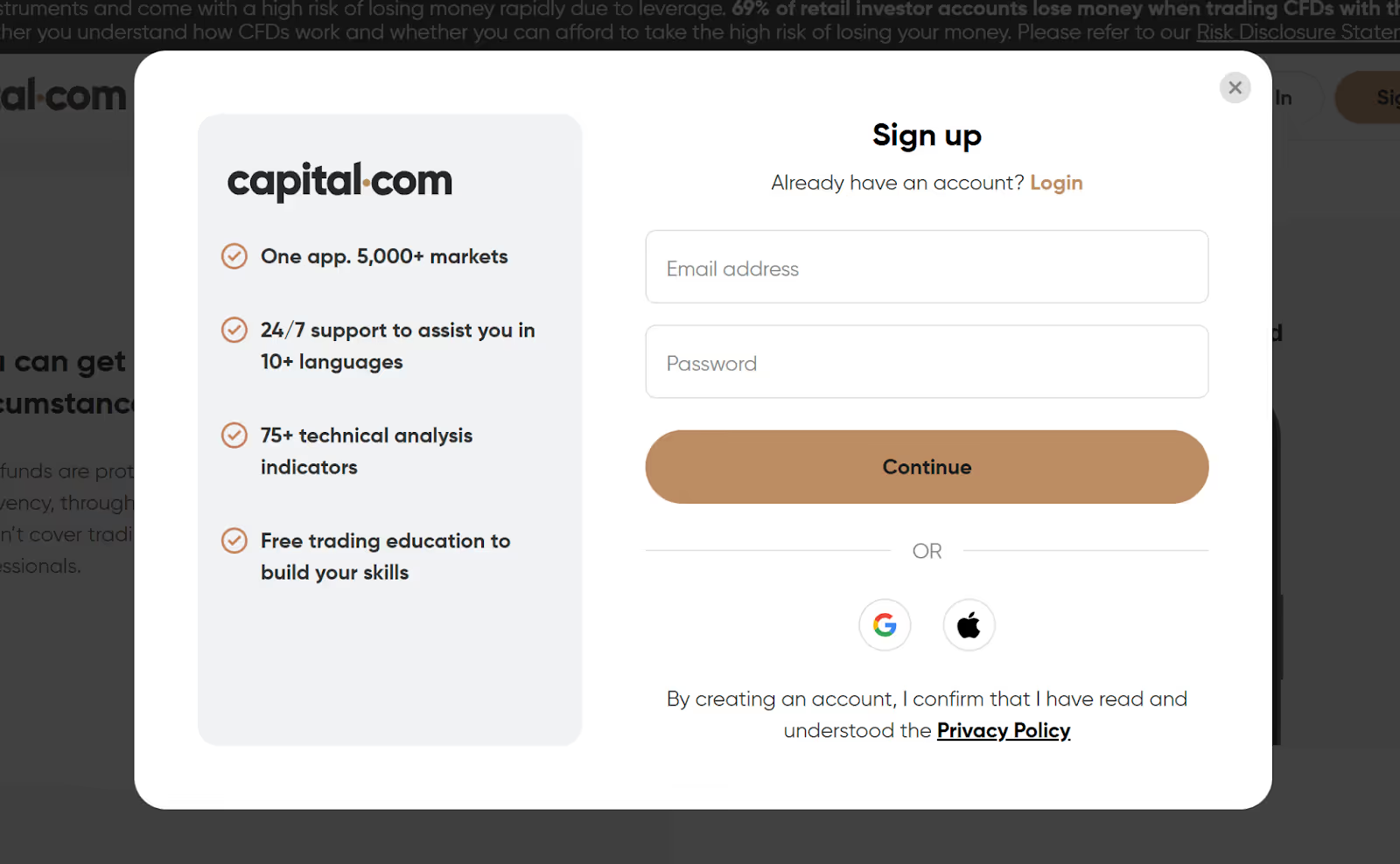
Account verification is usually completed within 24 hours, and users can start with a demo account before trading with real money.
Customer support
Capital.com offers 24/5 customer support in multiple languages via:
- Live chat (on web and mobile)
- Phone support (during business hours)
- Help center and FAQs
Support quality is generally rated as good, though response times can vary during high-traffic periods.
Final verdict: Is Capital.com worth it?
Capital.com offers a modern, regulated, and user-friendly CFD trading platform that’s ideal for European traders seeking to speculate on short-term price movements in stocks, ETFs, forex, commodities, and cryptocurrencies.
Its zero-commission structure, advanced charting tools, and integration with MT4 and TradingView make it appealing to active traders who understand leveraged products.
However, it’s not suitable for long-term investors seeking to own real assets or collect dividends. Overnight financing fees can accumulate, and CFD trading inherently carries a higher level of risk.
If your goal is active trading and you’re aware of the risks, Capital.com is a strong contender among Europe’s CFD brokers. But if you’re focused on long-term wealth building and real asset ownership, a traditional broker like DEGIRO or Interactive Brokers will likely be a better fit.
Disclaimer: CFDs are complex instruments and come with a high risk of losing money rapidly due to leverage. 69% of retail investor accounts lose money when trading CFDs with this provider. You should consider whether you understand how CFDs work and whether you can afford to take the high risk of losing your money.



